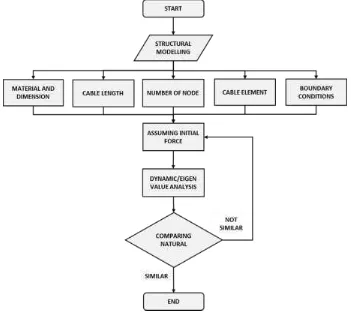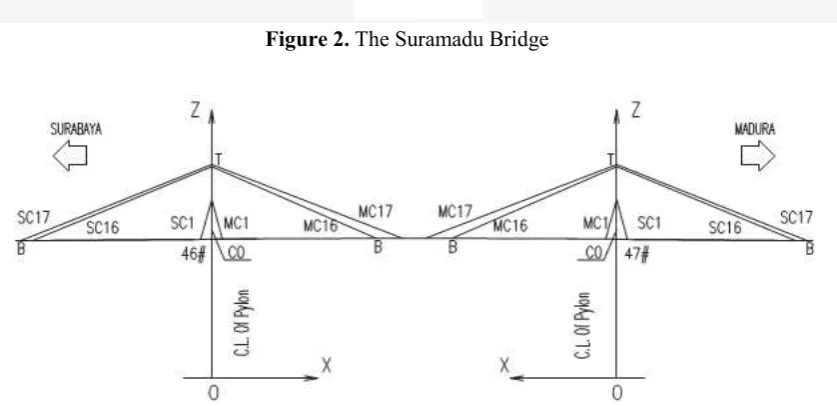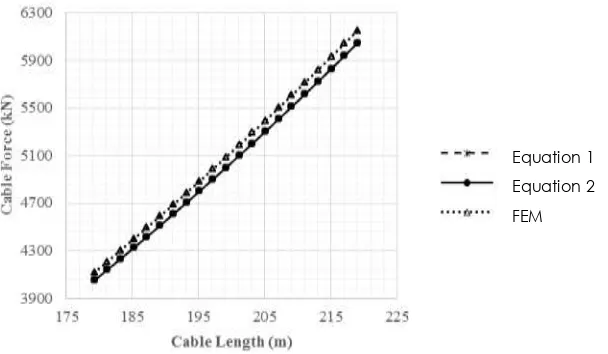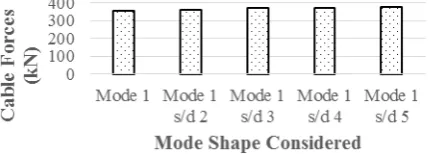IOP Conference Series: Earth and Environmental Science
PAPER • OPEN ACCESS
The analysis of cable forces based on natural
frequency
To cite this article: Made Suangga et al 2017 IOP Conf. Ser.: Earth Environ. Sci.109 012028
View the article online for updates and enhancements.
Related content
Natural frequency changes due to damage in composite beams
I Negru, G R Gillich, Z I Praisach et al.
-Optimization of natural frequencies of large-scale two-stage raft system LV Zhiqiang, HE Lin and SHUAI Changgeng
-Influence of the thrust bearing on the natural frequencies of a 72-MW hydropower rotor
S. Cupillard and J.-O. Aidanpää
The analysis of cable forces based on natural frequency
Made Suangga, Irpan Hidayat, Juliastuti, Darwin Julius Bontan
Civil Engineering Department, Faculty of Engineering, Bina Nusantara University Jakarta, Indonesia 11480
Corresponding author: [email protected]
Abstract. A cable is a flexible structural member that is effective at resisting tensile forces. Cables are used in a variety of structures that employ their unique characteristics to create efficient design tension members. The condition of the cable forces in the cable supported structure is an important indication of judging whether the structure is in good condition. Several methods have been developed to measure on site cable forces. Vibration technique using correlation between natural frequency and cable forces is a simple method to determine in situ cable forces, however the method need accurate information on the boundary condition, cable mass, and cable length. The natural frequency of the cable is determined using FFT (Fast Fourier Transform) Technique to the acceleration record of the cable. Based on the natural frequency obtained, the cable forces then can be determine by analytical or by finite element program. This research is focus on the vibration techniques to determine the cable forces, to understand the physical parameter effect of the cable and also modelling techniques to the natural frequency and cable forces.
Keywords: cable forces, vibration, natural frequency, FFT Technique
1. Introduction
A cable is a flexible structural member that is effective at resisting tensile forces. It helps to think of the cable element as a piece of rope. Its high flexibility makes it unstable to provide compressive, bending or shear resistance. A cables are crucial element for the overall structural safety of cable supported bridge such as main cable of suspension bridges, hanger of suspension bridges and arch bridges, and stayed cable for cable stayed bridges. Therefore the accurate estimation of tension force plays an important role in the construction and the maintenance stages of the bridges [2]. .
For Maintenance of cable supported bridges such as Suspension Bridges, Cable Stayed Bridge and Arch Bridge, the cable forces need to measure and monitor continuously. The condition of the cable forces in the cable supported structure is an important indicator whether the bridge structures is in good condition or not. The determination of the cable forces, not only can provide the basis for overall evaluation of the structure, but also can be used to monitor the anchorage system and boundary condition of the cable is still in good condition or whether some unexpected problem has occurred.
Several method has been developed to measure on site cable forces including vibration techniques, installation of strain gauge, and installation of electromagnetic sensor. Vibration technique using correlation between natural frequency and cable forces is a simple method to determine in situ cable forces, however the method need accurate information on the boundary condition, cable mass, and cable length.
The International Conference on Eco Engineering Development 2017 (ICEED 2017) IOP Publishing
This research is focus on the vibration techniques to determine the cable forces, to understand the physical effect of the cable and also modelling techniques to the cable forces. It is include the study on boundary condition, number of nodes for FEM, mass and length effect as well as the number of higher frequencies to the accuracy of the result of the analysis. Two cases study will be considered for the analysis: The Suramadu Bridges and The Siak III Bridge.
The relation of natural frequency and cable forces is indicated in the following formula [1] :
2 2 2
2 i
2 2
4ml f
π EI
p=
- i
i
l
(1) For stayed cable and bridge hanger where diameter of the cable is relatively small comparing to thelength, the value of 2
2
π EI
l
has small contribution to the cable forces, therefore it can be neglected. The formula can be simplified into:
2 2 i 2
4ml f
p=
i
(2)2. Methodology
2.1. Research Methodology
To determine the cable forces from it natural frequency using finite element software, the trial and error method analysis is required. The procedure is as indicated in Figure 1.
Figure 1. Flowchart to determine cable force using FEM
The International Conference on Eco Engineering Development 2017 (ICEED 2017) IOP Publishing
IOP Conf. Series: Earth and Environmental Science109(2017) 012028 doi:10.1088/1755-1315/109/1/012028
2.2 Object Research
Case Study I : Stayed Cable of The Suramadu Bridge
The Suramadu bridge is located in the northern part of east Java province of Indonesia. It spans Madura strait and connects Surabaya with Madura Island. It consist of 3 structural type ; PCI Girder for Causeway, Balace Cantilever Concrete Box Girder for Approach Bridge and Cable Stayed bridge for Main Bridges as shown in Figure 2.
Structure type of the main bridge is cable stayed bridge with steel-concrete composite beam and double pylons and double cable faces. The span arrangement is 192+434+192m=818m. The bridge has 4 lanes for traffic, and the width of the bridge deck is 30m. The arrangement for stayed cable is presented in Figure 3.
Figure 2. The Suramadu Bridge
Figure 3. Stayed cable id for the Suramadu Bridge
Stayed Cable SC4 is used to study the following parameter were the effect of boundary condition to the cable’s natural frequency, the effect of number of node to the cable’s natural frequencies, the effect of cable length to the cable’s force, the effect of cable mass to the cable’s forces. The properties of Cable SC4 are presented in Table 1.
Table 1. Stay cable properties for cable SC4
Stay Cable Properties
The values
p (cable tension)
4997.8 kN
m (mass of cable per unit length)
0.0855 t/m
L (cable length)
199.133 m
E (modulus elasticity)
2.05 x 108 kN/m
2A (cross
–
section)
0.0108911 m
2D (diameter)
0.11775814 m
I (inersia)
9.4392 x 10-6 m
4f (natural frequency)
0.607 Hz
The International Conference on Eco Engineering Development 2017 (ICEED 2017) IOP Publishing
Case Study II : Hanger elements of Siak III Arch Bridge
The Siak III bridge is located in the Sumatran City of Pekanbaru of Indonesia. The total length of the bridge is 520 m. Structure type of the main bridge is steel arch bridge. The span arrangement is 25+120+25m=170m. The width of the bridge deck is 11m. Cable element used for hanger of the arch bridge. The length of the cable hanger is presented in Figure 5.
3. Result and Discussion
Three boundary condition are considered to investigate the effect of the boundary condition to the natural frequency by assuming the constant cable forces. The result of the analysis are presented in table 2 and figure 4.
Table 2. The effect of boundary condition to the natural frequencies
Figure 4. The effect of boundary condition to the natural frequencies
The Effect of Boundary Condition to the Natural Frequencies
Three boundary condition are considered to investigate the effect of the boundary condition to the natural frequency by assuming the constant cable forces. The result of the analysis are presented in table 2 and figure 4
Based on figure 4 it can be concluded that for FEM dynamic analysis of the cable, the
boundary condition has no significant effect to the natural frequency.
Mode
Natural Frequencies (Hz)
Forces (kN)
Fixed-Fixed
Pin
–
Pin
Pin - Fixed
1
0.602
0.602
0.602
4997.8
2
1.208
1.208
1.208
3
1.822
1.822
1.822
The International Conference on Eco Engineering Development 2017 (ICEED 2017) IOP Publishing
IOP Conf. Series: Earth and Environmental Science109(2017) 012028 doi:10.1088/1755-1315/109/1/012028
The Effect of the Number of Node to the Natural Frequency
The effect of number of node in the structural modelling to the natural frequency has been
investigated by considering cable modelling with 4 to 20 nodes. The result of the first 5
modes has been compared. The results of the analysis has been presented in table 3 and
figure 6.
Figure 5. Siak III Bridge
Table 3. The effect of the number of node to the natural frequency
Number of Node Natural Frequency (Hz) Mode
1 2 3 4 5
4 0.629 1.406 13.292
6 0.612 1.292 2.047 2.829 12.934
8 0.606 1.243 1.941 2.721 3.563
10 0.604 1.227 1.887 2.601 3.382
12 0.603 1.219 1.859 2.537 3.262
14 0.603 1.214 1.843 2.499 3.190
16 0.602 1.211 1.833 2.475 3.144
18 0.602 1.209 1.827 2.460 3.114
20 0.602 1.208 1.822 2.449 3.092
The International Conference on Eco Engineering Development 2017 (ICEED 2017) IOP Publishing
Figure 6. The effect of the number of node to the natural frequency
Based on figure 6, for the first mode, the number of node in cable modelling has less significant effect comparing to the higher mode. For the second mode, at least 8 nodes are required for the cable modelling.
The Effect of the Cable length and cable Mass to the Cable Forces
The effect of the cable length to the cable forces has been investigated by varying the length
of the cable at constant natural frequency. The result on analysis are presented in figure 7.
Figure 7. The effect of the cable length to the cable forces (f = 0,607 hz)
Based on figure 7, it can be seen that the cable length and cable forces has almost linear relationship. The gradient is 101.9305 kN/% of length.
The effect of the cable mass to the cable forces has been investigated by varying the mass of the cable at constant natural frequency. The result on analysis are presented in figure 8.
Equation 1
Equation 2
FEM
The International Conference on Eco Engineering Development 2017 (ICEED 2017) IOP Publishing
IOP Conf. Series: Earth and Environmental Science109(2017) 012028 doi:10.1088/1755-1315/109/1/012028
Figure 8. The effect of the cable mass to the cable forces (f = 0,607 hz)
Effect of the Higher Frequency to the Cable’s Tension
To determine the effect of the higher frequency to the cable’s tension, cable hanger 1 and 10 was considered by applying equation (1). The cable forces is determined by considering 1 to 5 modes. The result are presented in figure 9 and figure 10. It can be see that the stable natural frequency value obtained using at least 3 modes.
Figure 9. Effect of the higher frequency to the cable’s tension for hanger no. 1
Figure 10. Effect of the higher frequency to the cable’s tension for hanger no. 10
4. Conclusion
From the analysis conducted, the following conslusion can be drawn
Boundary condition adopted for FEM modelling of the cable has less significant effect to the natural frequency;
For the first mode, the number of node in cable modelling has less significant effect. For the second mode, at least 8 nodes are required in the cable modelling;
Both cable length and cable mass has significant effect to the result of cable tension. Therefore in determining the cable forces, the accurate input of both parameters are mandatory.
When calculating the cable forces using equation (1), at least 3 modes shall be considered to increase the accuracy of the analysis
The International Conference on Eco Engineering Development 2017 (ICEED 2017) IOP Publishing
References
[1] Casas J.R., A combined method for measuring cable forces: the cable-stayed Alamillo Bridge, Spain, Structural Enginering International, Journal of the IABSE, Vol.4, No.4, pp.235-240, November 1994.
[2] Debora, S. Nancy., Parivallal, S., Ravisankar., K., Hemalatha, G. (2015). Evaluation of Cable Tension Using Vibration Based Methodologies for Health Monitoring of Structures. IJIRSET, Vol.4, Special Issue 6.
[3] Chang, Sung-Pil., et al. (2008). Nonlinear Dynamic Analysis of Spatial Suspended Elasti Catenary Cable with Finite Element Method. KSCE Journal of Civil Engineering, 12 (2), 121-128.
[4] Eklund, Alice. (2006). Measurement and Evaluation of Cable Forces in the Alvsborg Bridge. Master Thesis, Royal Institute of Technology, Stockholm.
[5] Kreyzig, Erwin. (2006). Advanced Engineering Mathematic. (9th Edition). Hoboken : Wiley. [6] Steiveman, D.B. (1953). A Practical Treatise on Suspension Bridges. New York : Wiley &
Sons Inc.
[7] Walther, R. Cable Stayed Bridges. (1988). (William Crozier, Penerjemah). London L Thomas Telford Ltd.
[8] Yamaguchi, Hiroki. (1992). Structural Dynamics. Thailand : Asian Institute of Technology. [9] Presentation Material - Presentasi Jembatan Siak III by Dr. Ing. Josia I. Rastandi, University
of Indonesia
The International Conference on Eco Engineering Development 2017 (ICEED 2017) IOP Publishing
IOP Conf. Series: Earth and Environmental Science109(2017) 012028 doi:10.1088/1755-1315/109/1/012028





